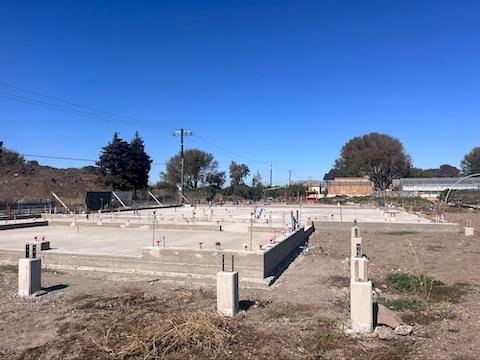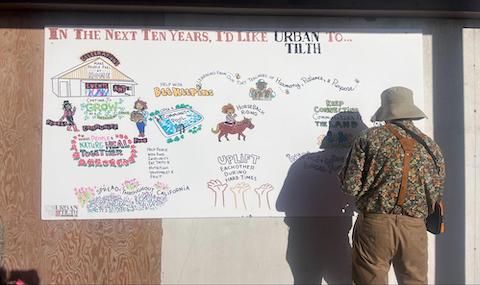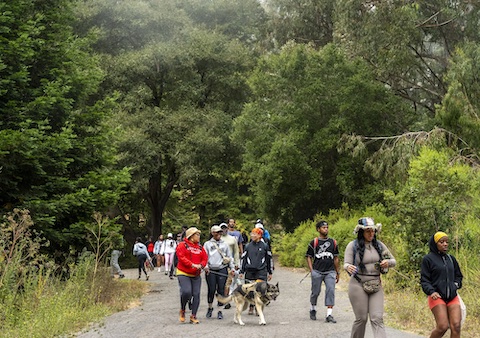
07 Nov ‘Keep Fighting’: North Richmond Pushes on After EPA Cancels $19 Million Climate Grant

The community resilience center in North Richmond sits unfinished as federal funds run dry.
Editor’s note: This story was originally produced and is being simultaneously published by Richmond Confidential at the UC Berkeley Graduate School of Journalism. This version has been lightly edited from the Confidential’s.
Story and photos by Lenéa Sims
Amid the rows of sunflowers, tomatoes and kale on a North Richmond farm, sits an abandoned concrete slab. It is the foundation of what was meant to be the area’s first community resilience center — a sanctuary for air-quality disasters and extreme heat that’s now stalled after the Trump administration revoked its funding.
The Environmental Protection Agency awarded Contra Costa County and local nonprofit partners $19 million last December under the Biden-era Inflation Reduction Act. But in March, under the new administration, the agency abruptly cancelled the grant, halting construction before the first wall could be raised.
“If we had an emergency today, there wouldn’t be any place that was prepared for people,” said Doria Robinson, a Richmond City Council member and executive director of Urban Tilth, which owns the North Richmond Farm where the center was being built.
The full plan, dubbed the North Richmond Resilience Initiative, comprised eight projects including the expansion of Wildcat Creek Trail, pollution-reducing tree planting at an elementary school, and an e-bike lending library.
After learning about the grant cancellation from a third party in March, Urban Tilth and Contra Costa County finally received a letter from EPA leadership in August, stating that it was a “priority of EPA to eliminate discrimination”and claiming the North Richmond initiative promoted “DEI or environmental justice initiatives.”
“This program was never discriminatory and was never about politics,” Contra Costa County Supervisor John Gioia said in a statement after receiving the letter. The EPA, Gioia said, was “targeting” North Richmond because it is a predominantly Latino and Black community.
Not only is North Richmond home to a majority of Latino, Black and Asian residents, but it has also been designated as a “disadvantaged” community by the California EPA, a term used to describe neighborhoods that face both disproportionate exposure to pollution and overlapping socioeconomic vulnerabilities such as low income, high unemployment and housing instability.
California EPA data places North Richmond among the most heavily polluted areas in the state, with a high concentration of hazardous waste facilities, cleanup sites and solid waste operations.
DANGEROUS AIR
For many Richmond-area residents, those statistics are underscored by memories of air-quality disasters.
Cheryl Lopez remembers rehearsing for her quinceañera in 2012 when a fire broke out at the Chevron refinery, triggering a giant plume of black smoke and shelter-in-place order.
>>From The Pulse Archives:
Youth React to Chevron Refinery Disaster<<<
Lopez lives next to the Chevron refinery and said her family struggles with asthma and cancer. She laments not knowing where to go the next time disaster strikes.
“My place, where I should feel safe, is right next to the place that’s harming me,” Lopez said.
>>>From The Pulse Archives:
Richmond’s Most Vulnerable Can’t Escape Dangerous Air<<<
Dr. Stephanie Holm, who researches the health effects of pollution and sits on the advisory council for the Bay Area Air District, said air pollutants can cause wide-ranging harm throughout the body.
Small particulates and gases released during refinery flares “can get all the way down into the deep parts of the lung and some of them can even cross into the bloodstream,” Holm said, and can be linked to various cancers. Children, older adults and people with preexisting conditions like asthma are especially vulnerable.
Holm explained that people’s risk increases as the amount of harmful particles soars and length of exposure time builds.
That’s why the Air District released a plan for North Richmond in 2024, stating resilience centers were “crucial” for protecting health.
“Having a space that people can go to to decrease their exposure is so important,” Holm said.
Advocates said it’s not a matter of if but when the next disaster hits. In 1989, an explosion at the Chevron refinery injured eight people and sent smoke drifting across the East Bay. In 1999, another blast released over 200 chemicals into the air, contaminating water sources and soil.
The 2012 fire sent 15,000 residents — many suffering from respiratory distress — to local hospitals. Richmond later sued Chevron, settling in 2018 for $5 million in damages.
>>From The Pulse Archives:
Even as Richmond works to address past refinery disasters, routine emissions events continue to expose residents to dangerous air. Between 2019 and 2022, Richmond’s Chevron refinery was responsible for more than half of all flaring incidents that exceeded emissions limits across the Bay Area, according to a 2023 Air District report. In 2019 alone, Chevron reported 38 flaring events — intentional burns of excess gases that release harmful pollutants into nearby neighborhoods.
‘KEEP FIGHTING’
The EPA has cancelled $29 billion worth of environmental justice grants that were funded by the President Biden-era Inflation Reduction Act in about 800 communities across the country, stalling jobs and slowing construction.
Contra Costa County has joined a class action lawsuit alongside other recipients across the country whose environmental justice grants were revoked, seeking to hold the EPA accountable for what they call an unlawful decision. The EPA has yet to respond to their claims in court.
Several other grant recipients, including a coalition of nonprofits, local governments and tribes across the country have sought another lawsuit in response to the EPA’s actions, arguing that the EPA’s decision to terminate the grants violates binding agreements to distribute congressionally mandated funds. Seeking to restore funding to 350 revoked Environmental and Climate Justice grants, this coalition’s class action lawsuit was dismissed by a federal judge and they are currently seeking an appeal.
“Environmental justice grants were created to address the real harm to public health in communities of color and low wealth communities,” said Kym Meyer, litigation director at the Southern Environmental Law Center, one of the organizations challenging the revocation. “The communities were promised transformative funding to address generations of injustice and now that’s being taken away.”
In the meantime, Urban Tilth is hoping to find alternative funding. To meet a permit deadline, the organization broke ground after the EPA awarded funds but before the cash hit its bank account. Then the cash never came, leaving the nonprofit on the hook.
“We had a little bit under $3 million that we had to raise to complete this project,” said Michelle Besada-Barquis, who works in fund development at Urban Tilth. “Now, we are at a $9 million deficit.”
The nonprofit is applying for state grants and looking towards philanthropy to fill in the gap, but Besada-Barquis said the path forward remains unclear.
“Because the EPA grant was cancelled across the board, there’s a lot more competition for funding,” Besada-Barquis said. “We’re really having to scramble.”
On a warm Saturday afternoon in October, Urban Tilth celebrated its 20th anniversary with a gathering at the North Richmond Farm. Guests congregated on the farm’s brick courtyard between the newly constructed watershed classroom and greenhouse.
Community members added shells, seeds, beans, feathers and chilis to an altar overflowing with marigolds. Guests wrote notes about their hopes for Urban Tilth’s future.
- Community members added shells, seeds, beans, feathers, and chilis to an altar ringed with marigolds at Urban Tilth’s anniversary event.
”Keep connecting communities to the land,” wrote one guest.
“Uplift each other during hard times,” said another.
Robinson stood behind the fundraising table looking out over the organization whose growth she’s overseen for two decades. Despite the recent setback, she’s keeping her vision: Build a hub for local food production, youth education and climate resilience.
Her message to others finding themselves facing off with the federal government is not to capitulate.
“Don’t believe that by bending the knee, you’re actually going to get anything but servitude,” Robinson said.
“Keep fighting.”
- A visual note taker who works under the name Silent James draws up community responses to the question “In the next 10 years, I’d like Urban Tilth to…” at Urban Tilth’s 20th anniversary party on Oct. 11
This story is part of “The Stakes,” a UC Berkeley Journalism project on executive orders and actions affecting Californians and their communities.








No Comments